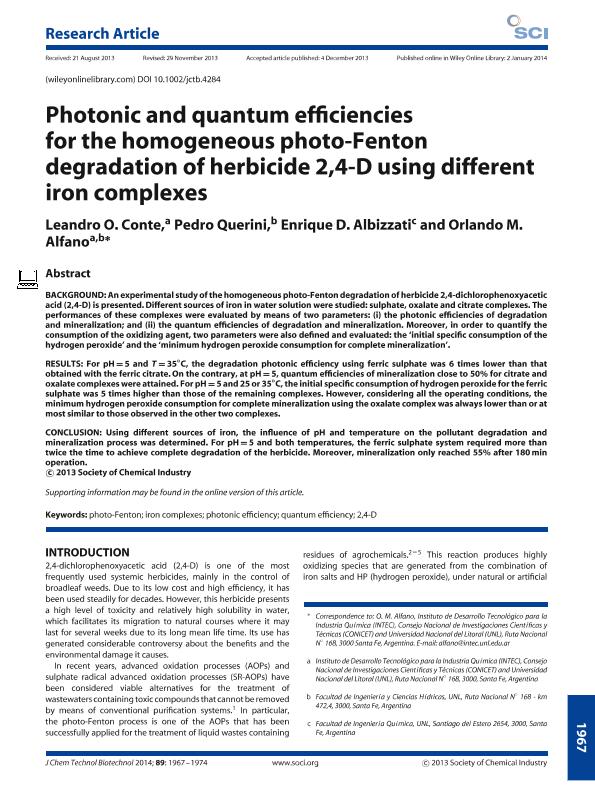Mostrar el registro sencillo del ítem
dc.contributor.author
Conte, Leandro Oscar

dc.contributor.author
Querini, Pedro
dc.contributor.author
Albizzati, Enrique
dc.contributor.author
Alfano, Orlando Mario

dc.date.available
2016-12-14T14:14:33Z
dc.date.issued
2014-01
dc.identifier.citation
Conte, Leandro Oscar; Querini, Pedro; Albizzati, Enrique; Alfano, Orlando Mario; Photonic and Quantum Efficiencies for the Homogeneus Photo-Fenton Degradation of a Herbicide 2,4-D Using Different Iron Complexes; Wiley; Journal Of Chemical Technology And Biotechnology; 89; 1-2014; 1967-1974
dc.identifier.issn
0268-2575
dc.identifier.uri
http://hdl.handle.net/11336/9324
dc.description.abstract
BACKGROUND: An experimental study of the homogeneous photo-Fenton degradation of herbicide 2,4-dichlorophenoxyacetic acid (2,4-D) is presented.Different sources of iron in water solution were studied: sulphate, oxalate and citrate complexes. The performances of these complexes were evaluated by means of two parameters: (i) the photonic efficiencies of degradation and mineralization; and (ii) the quantum efficiencies of degradation and mineralization. Moreover, in order to quantify the consumption of the oxidizing agent, two parameters were also defined and evaluated: the initial specific consumption of the hydrogen peroxide and the minimum hydrogen peroxide consumption for complete mineralization. RESULTS: For pH=5 and T =35ºC, the degradation photonic efficiency using ferric sulphate was 6 times lower than that obtained with the ferric citrate.On the contrary, at pH=5, quantum efficiencies of mineralization close to 50% for citrate and oxalate complexes were attained. For pH=5 and 25 or 35ºC, the initial specific consumption of hydrogen peroxide for the ferric sulphate was 5 times higher than those of the remaining complexes. However, considering all the operating conditions, the minimum hydrogen peroxide consumption for completemineralization using the oxalate complex was always lower than or at most similar to those observed in the other two complexes. CONCLUSION: Using different sources of iron, the influence of pH and temperature on the pollutant degradation and mineralization process was determined. For pH=5 and both temperatures, the ferric sulphate system required more than twice the time to achieve complete degradation of the herbicide. Moreover, mineralization only reached 55% after 180 min operation.
dc.format
application/pdf
dc.language.iso
eng
dc.publisher
Wiley

dc.rights
info:eu-repo/semantics/openAccess
dc.rights.uri
https://creativecommons.org/licenses/by-nc-sa/2.5/ar/
dc.subject
Photo-Fenton
dc.subject
Solar Energy
dc.subject.classification
Ingeniería de Procesos Químicos

dc.subject.classification
Ingeniería Química

dc.subject.classification
INGENIERÍAS Y TECNOLOGÍAS

dc.title
Photonic and Quantum Efficiencies for the Homogeneus Photo-Fenton Degradation of a Herbicide 2,4-D Using Different Iron Complexes
dc.type
info:eu-repo/semantics/article
dc.type
info:ar-repo/semantics/artículo
dc.type
info:eu-repo/semantics/publishedVersion
dc.date.updated
2016-12-12T13:44:45Z
dc.journal.volume
89
dc.journal.pagination
1967-1974
dc.journal.pais
Reino Unido

dc.journal.ciudad
Londres
dc.description.fil
Fil: Conte, Leandro Oscar. Consejo Nacional de Investigaciones Científicas y Técnicas. Centro Científico Tecnológico Santa Fe. Instituto de Desarrollo Tecnológico para la Industria Química (i); Argentina
dc.description.fil
Fil: Querini, Pedro. Universidad Nacional del Litoral. Facultad de Ingeniería y Ciencias Hídricas; Argentina
dc.description.fil
Fil: Albizzati, Enrique. Universidad Nacional del Litoral. Facultad de Ingeniería Química; Argentina
dc.description.fil
Fil: Alfano, Orlando Mario. Consejo Nacional de Investigaciones Científicas y Técnicas. Centro Científico Tecnológico Santa Fe. Instituto de Desarrollo Tecnológico para la Industria Química (i); Argentina. Universidad Nacional del Litoral. Facultad de Ingeniería y Ciencias Hídricas; Argentina
dc.journal.title
Journal Of Chemical Technology And Biotechnology

dc.relation.alternativeid
info:eu-repo/semantics/altIdentifier/doi/http://dx.doi.org/10.1002/jctb.4284
dc.relation.alternativeid
info:eu-repo/semantics/altIdentifier/url/http://onlinelibrary.wiley.com/doi/10.1002/jctb.4284/abstract
Archivos asociados
